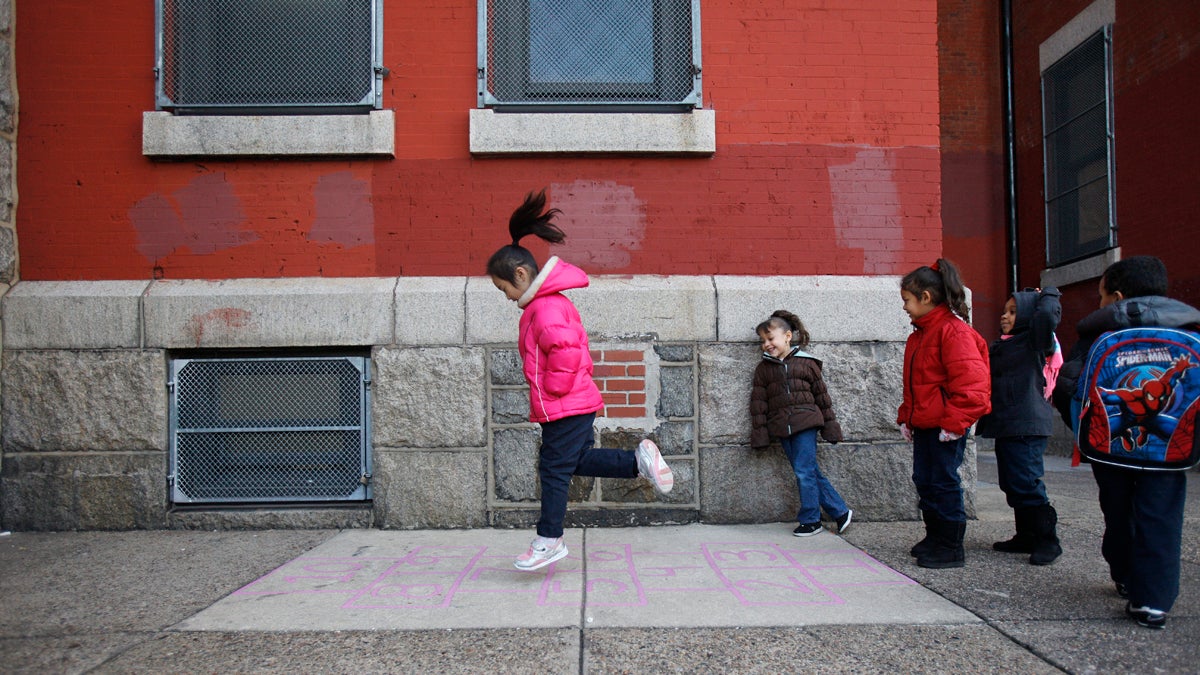What does a state education formula do?
Listen
Students play hopscotch outside of Isaac A. Sheppard Elementary, a K-4 neighborhood school in Philadelphia, Pa. (Photograph by Jessica Kourkounis)
Political and legal pressure for a state education formula is mounting. A statewide coalition of advocacy groups is pushing Harrisburg to enact a formula that promotes equity for students and fairness for taxpayers.
Fourth in an occasional series of podcasts and web “explainers.” To listen to the podcast, click the audio player above.
Nationally, most education funding comes from local sources, but all state governments contribute to school costs in some way. Most of the time, the state programs compensate in some way for differences in property wealth, income levels, and taxing capacity among school districts.
Most states also have a formula that guides how the aid is distributed among districts in a consistent way from year to year, based on factors such as enrollment, local wealth, and student characteristics.
Ideally, formulas are designed to make sure all districts have adequate funds and to promote equity among districts. The particulars of each formula differ, but normally, richer districts get less state aid, while poorer districts depend on the state for much of their education money.
Is anyone proposing an education funding formula?
The state’s General Assembly has established a bipartisan House-Senate group — the Basic Education Funding Commission. Its 15 members, mostly lawmakers, are charged with “developing and recommending” to the legislature a “new formula” to govern how basic education aid is distributed to districts. That type of aid makes up more than half of the state dollars sent to districts, about $5.5 billion this year.
Political and legal pressure for a formula is mounting. A statewide coalition of advocacy groups is pushing Harrisburg to enact a formula that promotes equity for students and fairness for taxpayers. (Disclosure: This coalition received funding from the William Penn Foundation, which under a separate grant is supporting the Multiple Choices reporting project.)
And a lawsuit challenging the current funding system is making its way through the state courts.
What is the Basic Education Funding Commission considering?
The commission’s job is to improve how Pennsylvania distributes basic education aid, which could help address what some view as inequitable variations in the resources available to districts. The group says any formula should take into account a district’s “relative wealth, local tax effort, geographic price differences, enrollment levels, local support,” and other factors.
The commission is not charged with examining “adequacy” – determining what each district needs and how much the state should contribute.
Is there agreement about what ‘adequacy’ means?
No. Some observers conclude that weak student outcomes, such as low graduation rates, are evidence that districts such as Philadelphia do not make good use of money and so should not get any more. Others say that high-poverty districts like Philadelphia get lower student outcomes because their students have great needs and the district does not have enough resources to meet them.
Do people agree about where the money should come from?
No. Although almost all states divide up education costs between local and state sources, determining how to do this and what the balance should be is the subject of intense political negotiation and conflict.
Most policymakers agree that state aid is meant to be a leveler and that poorer districts should get more state aid than richer ones. That happens even under the current Pennsylvania system, which many criticize. The issue is how much leveling of resources is enough.
States and localities often squabble over who is more responsible for meeting educational needs and whether local districts carry their fair share.
When states cut back education spending, more of the burden falls on local taxes, usually property taxes. Sometimes those taxes become intolerable, especially for seniors on fixed incomes. This has led to proposals to eliminate local property taxes and raise school money through other means, such as payroll or sales taxes.
Gov. Tom Wolf’s ambitious first budget proposal calls for higher educational spending, but also some property tax relief, enabled by a tax on natural gas drilling, a broader, bigger sales tax and other measures.
Do people disagree about how state aid should be distributed?
Most state funding formulas look at overall district needs.
But some experts, including Georgetown University professor Marguerite Roza, who is a consultant to the Basic Education Funding Commission, advocate a system that starts by calculating the needs of the individual child, including any special services required, and provides each with a virtual “backpack” of money that follows the child to his or her school.
Although some advocacy groups also favor this approach as a way to target more funds to the neediest students, they are leery that it could be used to send students and public funds to private schools.
Another area of controversy is the “hold-harmless” provision, which guarantees that every district will get no less than the year before, even if its student population goes down. The Pennsylvania school code now guarantees that every district, no matter how rich, will get some state money. That’s called “minimum subsidy.” As a result, wealthier districts get millions in state aid that some advocates argue they could manage without, while students in poorer districts may go without basic services.
Is there any prospect for immediate change?
The Basic Education Funding Commission, which is holding hearings statewide, is expected to make a report in June. What happens to its recommendations becomes a political matter to be debated by the General Assembly and Gov. Wolf.
Wolf campaigned last year in favor a state formula, and has proposed a state budget that calls for many changes in the state tax structure to raise more money for education aid. His proposal is so sweeping that it seems possible the state government will not agree on a new budget by the normal June 30 deadline, and that the debate will continue deep into the summer.
In the Multiple Choices podcast, Keystone Crossroads senior education writer Kevin McCorry joins with Paul Socolar, publisher and editor of the Public School Notebook, and Notebook contributing editor Dale Mezzacappa to explain and explore the history, complexities and controversies of public education funding in Pennsylvania.
Look for new installments of Multiple Choices every week for the rest of the spring, as the General Assembly reviews Gov. Wolf’s ambitious school funding and tax plan.
WHYY is your source for fact-based, in-depth journalism and information. As a nonprofit organization, we rely on financial support from readers like you. Please give today.





